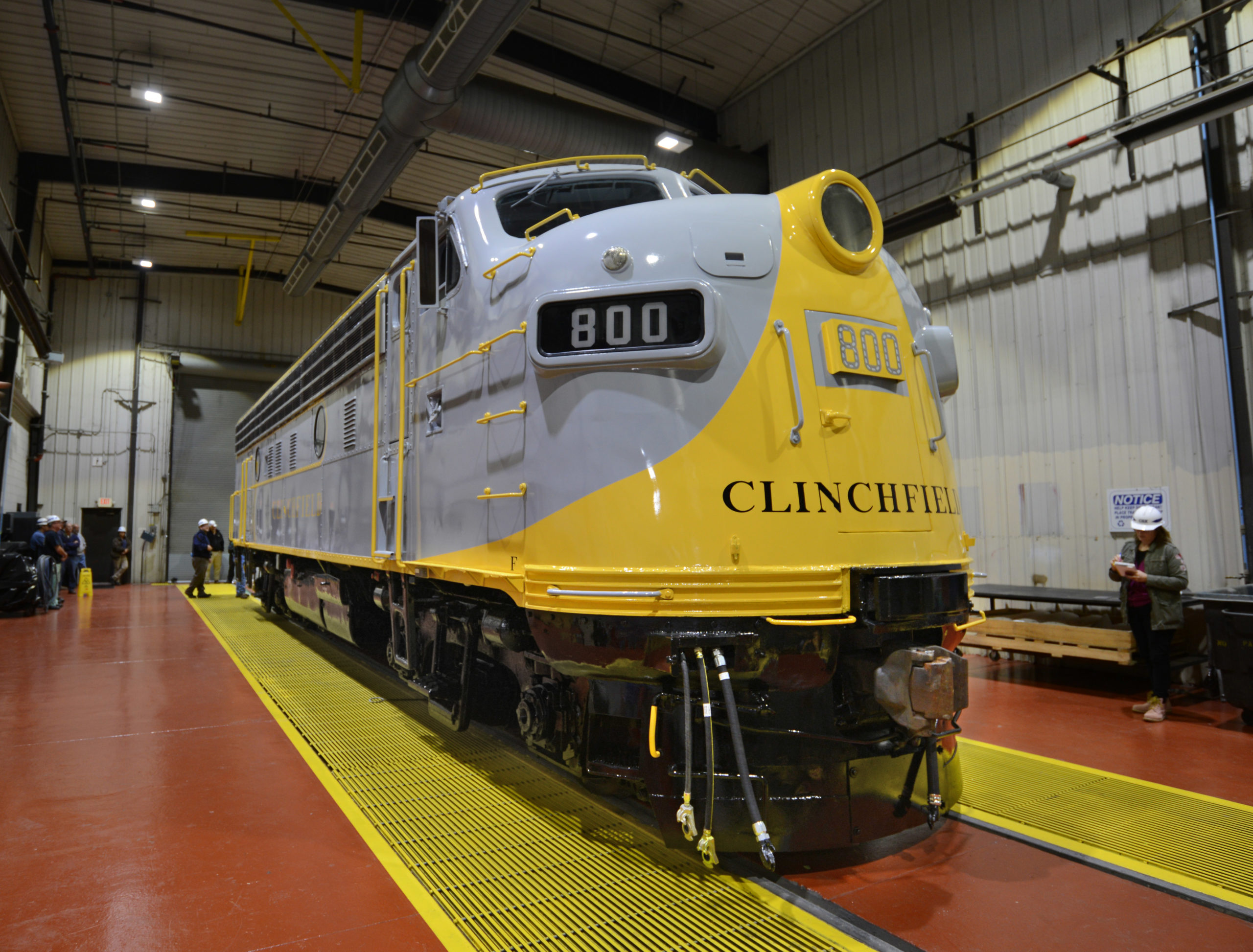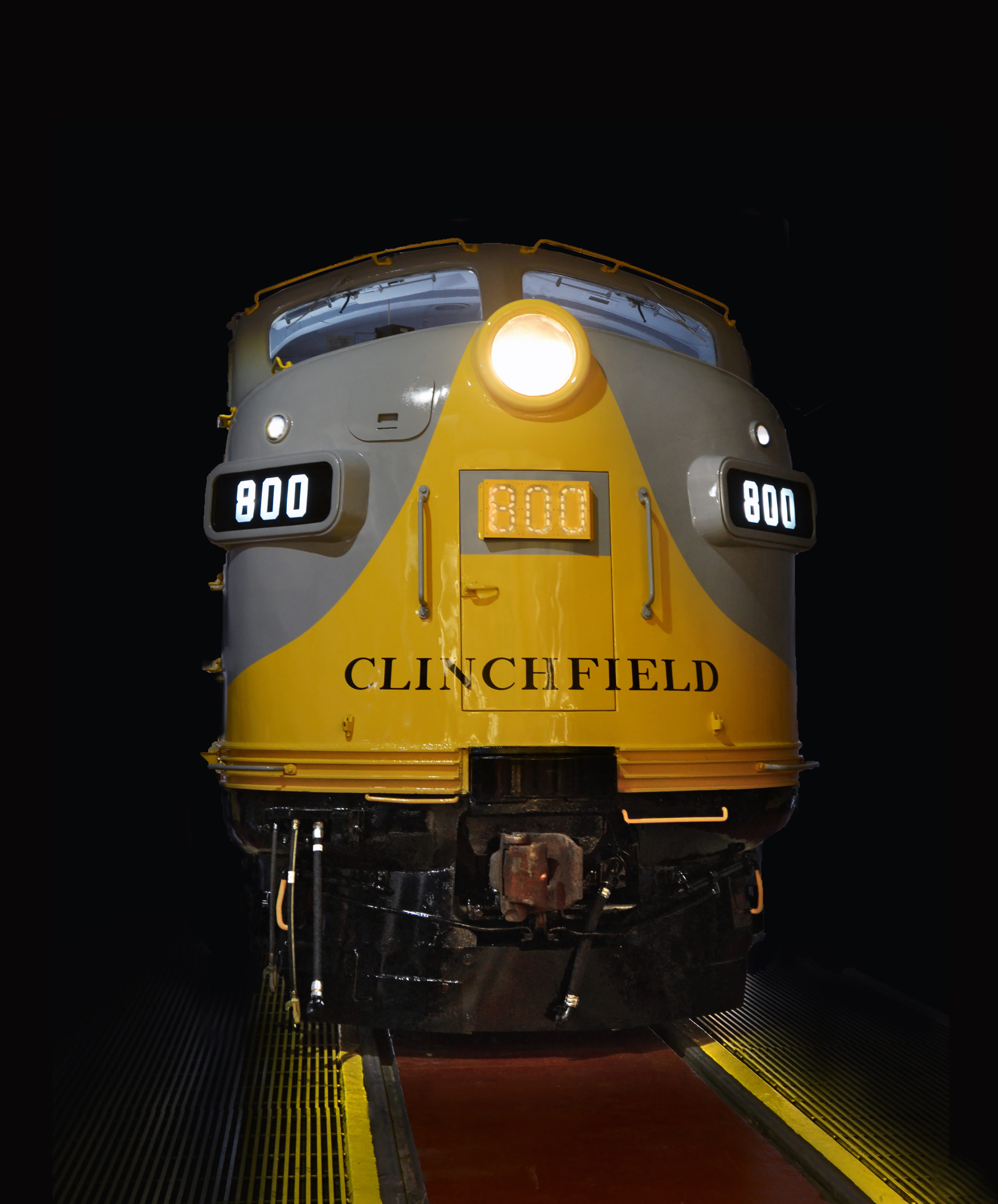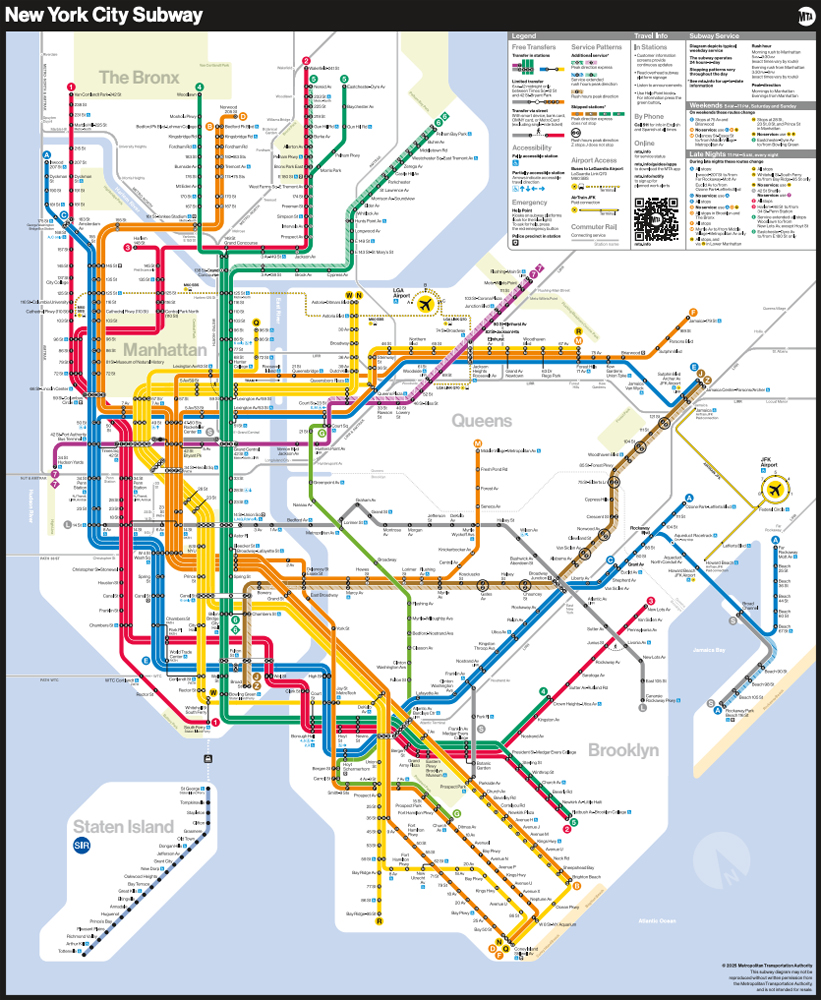
HUNTINGTON, W.Va. — Children and railfans waiting along the route of CSX’s Santa Train this year will get an extra treat from Santa Claus — an original Clinchfield Railroad F unit in new paint pulling the trainload of cheer.
CSX Transportation unveiled the cosmetically restored Clinchfield F3 No. 800 in yellow and gray at its Huntington locomotive shops today. The interior and exterior restoration of the already operating locomotive coincides with the 75th running of the annual Santa Train over the former Clinchfield main line from Shelby, Ky., to Kingsport, Tenn., on Nov. 18.

CSX shop crews spent months searching for old drawings and diagrams on the Clinchfield’s first diesel-electric locomotive, so they could re-paint it as closely as possible to what it looked like when it rolled out of EMD’s LaGrange, Ill., works in 1948. Present-day railroaders even quizzed retired Clinchfield engineers on details such as internal paint and seat colors to ensure historical accuracy of the restoration — although the locomotive must operate with ditch lights to comply with modern safety laws.
The unit was first assigned to lead the Santa Train in 1979, and several subsequent runs as Seaboard System and later CSX No. 116. The last time F-units pulled the Santa Train was in 1989, with No. 800.
No. 800 was built as a Phase V F3A — although railroad historians may refer to it as an F5, due to it being a transitional model to the F7. The locomotive immediately went to work pulling Clinchfield’s hotshot freights, perishables trains, and coal drags, displacing the road’s Challenger-type 4-6-6-4 steam locomotives. As more and newer locomotives were added to the roster, the railroad upgraded No. 800 to F7 specs in 1952.
By the early 1970s, the railroad repainted No. 800 in solid black with yellow lettering and trim. As attractive as the first gray and yellow was on early locomotives, it was a constant battle to keep the motive power roster clean of grime and exhaust smoke on a mountain railroad of heavy coal tonnage, grades, and more than 50 tunnels.
The railroad repainted No. 800 into “Family Lines” gray, yellow, and red in 1979. When Seaboard System folded into the Chessie System and emerged as CSX Transportation in 1986, No. 800 and three other cab units were repainted into an early version of gray and blue. No. 800 even wore “CSX Transportation” on the side for about a week as management considered different variations of liveries.
In 1988, No. 800 was one of four F units assigned to a test operation for General Motors’ RoadRailer service between Detroit and Atlanta. In sets of two, the Fs handled this operation until nearly the end, when conventional hood units took over. It was most likely the last time F-units were used in everyday regular line-haul freight operations on a Class I railroad.
By 1990 “bright future” CSX blue, gray, and with a bright yellow nose/trim was applied to No. 800. It was later briefly used on American European Express’s luxury Chicago-Washington service before going to MARC for use on commuter train service out of Baltimore and Washington. No. 800 as No. 116 was retired serviceable in 1993.
At the request of CSX Chairman Emeritus Hays Watkins, the locomotive was donated to the C&O Historical Society, and placed on display with a host of other equipment at Clifton Forge, Va. As a revenue generator for the society, the unit was leased to the Potomac Eagle operation and repainted “C&O 8016.” The unit was one of those present at the “Streamliners at Spencer” event in May 2014.
Joining No. 800 on this year’s Santa Train will be Clinchfield No. 3632. The volunteers from the Southern Appalachia Railroad Museum in Oak Ridge, Tenn., joined forces with East Tennessee Rail Car Services to restore a privately owned ex-Seaboard Coast Line SD45, No. 2024. This meticulously restored 3,600-hp unit is identical to seven such units SCL traded to the Clinchfield for a like number GE U36Cs in 1977. No. 2024 was renumbered to the next available slot above those units, 3632, and re-lettered exactly as the Clinchfield’s units.














Somebody please get a picture of 800 as it passes that Union Church, the one where the track goes right in front of the main entrance. I wish I could chase this train myself, but I can’t get away.
Wow!….just Wow!!
Thanks Ron! Very good news that the 800 will be leading.
I’ve worked the Santa Train three times in the past 11 years and sure wish I’d been offered the opportunity this year.
Anyone who has the Spring 2015 issue of Classic Trains Magazine will find a nice photo on page 69, of this locomotive leading a freight train near Johnson City Tenn on June 6, 1971. Loco looks a little weathered, but, otherwise, no worse for the wear. .And, yes. Photo was taken before it was upgraded to F-7 specs.
Is this really a F3 ??
Just fantastic! And Ron’s head-on spotlight shot of that timeless bulldog nose is fabulous as well.
For Curt Warfel: The standard cab in the lead policy is a more recent thing–over the last 20 to 25 years for the reason you cited. However, with the addition of CSX safety teams at each stop, plus other measures, the 800 will indeed be on the point. Going back to the days (before 2005) when candy and gifts were thrown off en route constantly, today’s concentration of crowds only at stopping points is much easier to control than the days of old, when it could be near chaos when the Santa train eased through—-usually with an F-unit on the point (or Ten Wheeler Number 1 from ’68 to ’78). A lot of thought and planning goes into this operation each year between CSX and the Kingsport Chamber of Commerce, and every contingency is addressed, particularly with respect to safety.
Frankly I’m a bit worried that this project could negatively impact the CSX operating ratio and EHH’s bonus. How can a ‘Santa Train’ bring anything to the bottom line?
I don’t see any ditch lights….doesn’t it need them to operate ? Very nice looking.
beautifully done. My best compliments to the CSX shop crews!
What a beautiful locomotive. Too bad there just aren’t very many of these still in operation any more. Technology sure has come a long way.
I wonder what Hunter thinks of this extravagance?
Mr. Anderson: No, not really. Freight locomotives don’t travel fast enough to make aerodynamics an issue.
Super! Is all I can say.
I would imagine the F unit will be in a trailing position. CSX prefers a standard cab locomotive leading because it provides better visibility at the front corners of the engine.
Given how people mill about the Santa Train “throw” locations”; this is especially important from a safety perspective.
OUTSTANDING! Simply wonderful.
The locomotives that currently pull Amtrak trains and many commuter trains across the country can’t match the beauty of E or F units. It is cool that the Clinchfield F unit was painted at the old C&O shops in my hometown of Huntington, WV. I’m sure the Santa Train will be attracting more followers this year.
Its a sad commentary when industrial design of the 1940’s blows today’s “design” out of the water! Great looking machine there!
Don’t you just love that classic F (and E also) nose? The design is truly timeless. I never get tired of seeing them. Long may it run.
The 800 was built as a late F3, but upgraded in 1957 to F7 specs. It just depends on how you want to define it. Yes, Hunter Harrison supported this project, otherwise it wouldn’t have been possible. I think the FRA can grant a waiver for ditch lights, based on the unit’s antiquity (it’s older than N&W 611), but temporary lights might be added as a normal safety precaution. CSX, SARM and East Tennessee Rail Car Services did more on this than anyone could imagine. On behalf of us geriatric Clinchfield fans, we can’t thank them enough. Most of these guys toiled in anonymity as well, so the “glory” was a team effort of many.
These old F units seem a lot more aerodynamic than the shoeboxes used today. Does that make much difference on heavy freight?
Be still my beating heart.
JOSEPH JASTRZEBSKI – exactly what I was thinking, but the only other no. 800 that I know operates on the Cuyahoga Valley Scenic Railroad, has ditch lights, yet is an FPA-4.